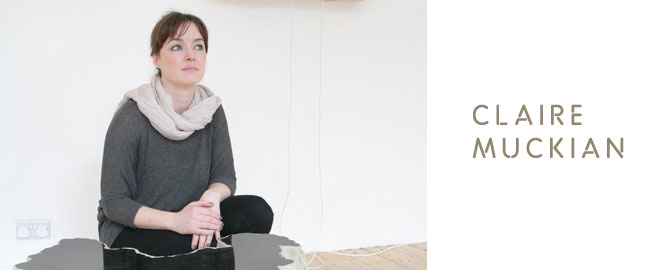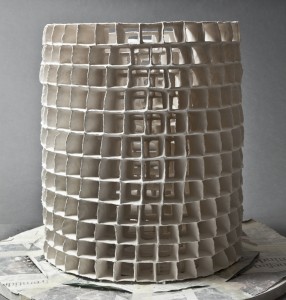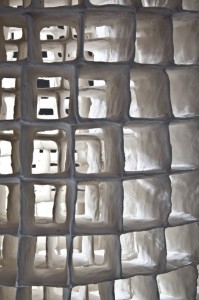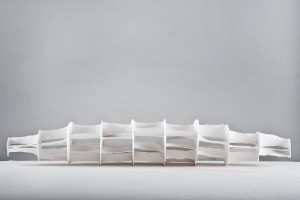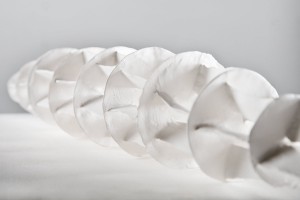Claire Muckian is not your every day ceramicist. Looking at her work it’s hard to categories her. However, be it Sculpture or Ceramics, she continuously blurs these two disciplines, where she manipulates and challenges the properties of clay, to create delicate and beautifully composed sculptures. We want to touch, stroke and feel the lightness of these deceivingly fragile looking pieces.
Muckian relies heavily on drawing, evidently using it to inform all aspect of her work. Her sculptures almost feel to be three-dimensional drawings themselves, where we can imagine Sculpture conceiving itself on a piece of paper, emerging through the medium of charcoal or graphite. The lack of colour allows us to enjoy the purity of the form without being interrupted by ‘outside noise’. This adds to fineness and elegance of the structures.
In a world full of visually demanding interruptions, it’s refreshing to be able to take a breath and to just simply enjoy a body of engagingly quiet work.
In her own words
What drives you to create? Have you ever felt like you had a choice?
Growing up in Ireland in the late 80’s/early 90’s, creativity through language, music and visual arts was strongly encouraged and so the desire to create was instilled from a very early age in that culturally rich environment.
Initially, I gravitated towards traditional Irish music but I slowly realised that this was not the correct creative forum for me. When I made the move into visual arts, I carried with me this sensibility of making, that is, adhering to a rigid basic structure but bringing to it an individual style. On reflection, ceramics has much in common with this mode of production with rules you must follow for a work to be successful in its making and firing. As I grow as an artist, however, I find myself rejecting this framework and I am much more interested in making in a much more uncontrolled way.
The drive to create is ego-driven to a certain extent – the desire to leave a deep scratch where you’ve been. I’ve always been keen to produce a body of work that is deeply original, creative and contribute in a valuable way to the repository of learning out there.
Yes, I do feel that I had a choice to create. I moved away from the arts for a number of years to pursue a different career, but I found what I was doing and the corporate world to be tedious and irrelevant. The desire to make work again began to assert itself and it became apparent that I should make a return to visual arts practice. Being a little older and having experienced other aspects of life has definitely had a positive influence on my work and I now bring to it a much richer, wider set of associations.
To me, your work is a delicate fusion between sculpture and ceramics. You certainly use a traditional medium in an unconventional manner. Did you start as a Sculptor or a Ceramist and has this been a conscious decision to fuse these disciplines together?
I would say that I am interested in materiality in general. I fell into ceramics as I found it to be an elegant way to make the terse concise forms I am interested in and allows the transference of immediacy and gesture into the work. Although I am interested in sculpture’s formal concerns, it wasn’t a conscious decision to fuse the disciplines of ceramics and sculpture. I think work is more interesting when it slips into these liminal areas.
I didn’t set out to use ceramics in an unconventional manner. I have a very specific aesthetic that I search for and I use whatever means of production to achieve this. I begin with a basic idea and then as the work begins to evolve I hope that it will take on a life and direction of its own. I think that if the work doesn’t change and evolve in the course of making, then why bother? Regarding the making, my work appears naïve but is deceptively well made. Accident and contingency play an important role in my making process, and so there is this tension between control and lack of control. I studied ceramics for 3 years on a Degree programme and so, am familiar with traditional ceramic techniques, I choose to adhere to or disregard these rules as necessary to achieve this aesthetic. I am aware that this approach may lend an ‘outsider’ feel to the work.
If I use the medium in an unconventional manner, it is because I look to contemporary art for influence. I adore contemporary Northern European art, especially Irish and Nordic. I’m not exactly sure how this genre differs from contemporary art in general but I think it has something to do with a fundamentally connected and associative way of thinking. I admire and am in awe of artists such as Joseph Beuys, Cy Twombly (sculpture), Dorothy Cross, Esther Klas and ceramic artists Bente Skjøttgaard, Nina Hole, Andrew Lord and Frances Lambe. I also find immense inspiration from art that was not intended to be art, for example, Shiva Linga paintings of Hindu Tantra and Kouzaki Hiromu’s envelopes made for no specific purpose but embodied with integrity and beauty.
What elements do you find most challenging in your work?
I very much enjoy challenges and experimentation. It is ok for these experiments to fail, as I will have learned something to feed into future work.
At the moment, I am limited in scale by the dimensions of the kilns I have access to. This has definitely been driving me to experiment materially to provide the freedom to make larger scale work. I would like to offer the viewer a more immersive experience, like walking through a landscape. A larger sculpture has the possibility to engage and activate the viewer beyond just the object itself.
Aside from that, the most challenging issue I have currently as a recent graduate is making a living from art and balancing making art with paid work. Whilst I make work for the love of it, it’s a matter of finding the balance between being creative and making it financially viable also. Because the type of work I make slips between both fine art and craft worlds and I don’t make a finished marketable product, this makes my work ineligible for many funding programmes available from crafts bodies. On a more positive note, I feel extremely lucky to be living and working in Belfast, where the arts scene is incredibly vibrant.
Do you ever switch between a variety of disciplines such as, drawing or painting when creating and building your work? Or do you stick to one medium, discipline or dimension?
I like to incorporate drawing into my practice. For me, drawing seems to fall into two categories – drawing as a means of exploring an idea and sculptor’s drawings as a method to problem solve. As a general rule, I do a lot of the former kind when beginning a new body of work and the latter throughout whatever project I am working on. I like to make hybrid drawing/paintings using inks, pencil, whatever materials I can get my hands on really. I exhibit these drawings regularly and people respond really well to them. I hope to focus on developing collage/drawings parallel with a new body of work that I’ve begun and making these into incredibly well-made, beautifully constructed objects that compliment and operate with the sculptural work.
I would very much like to explore photography and possibly moving-image work in the future, but I just need the right time and forum to do this.
When exhibited do you think people come to see a body of traditional ceramics? When people come to your exhibitions how do you want people to feel and walk away?
I have exhibiting my work in both Craft and Fine Art contexts. When displayed in a craft context, people are always keen to impose a use on the objects I make and in their minds translate what they would be like as functional objects, with well-meaning suggestions like ‘Have you ever thought about making these into candle holders?’ The work just doesn’t suit being placed in this context. These viewers recognise the traditional language of the materials, but not necessarily what I am trying to achieve with them.
Where I have exhibited more recently, in contemporary art galleries and project spaces, I don’t think people expect to find ceramics. They always seem surprised and delighted with what the medium can offer. The response I have had from viewers is that the work makes the gallery feel like a quiet, contemplative space with the viewer becoming aware of their presence in the space and aware of how they operate in response to the objects. This is exactly how I’d hoped viewers would respond to my work. It is always fascinating to hear how people read into the works according to their own life experiences and visual benchmarks. I never tire of that.
Having a unique position in society, I believe that it is the artist’s responsibility to offer the viewer insights that lead to an enhanced understanding of the world. For me, I try to offer up a distilled vision of the world. I think the most successful work is slightly jarring and doesn’t immediately reveal itself on first viewing. It is ok for me that the work is not immediately accessible, because all worthwhile things in life are always worth a little hard work!
Can you describe and discuss your most recent work?
Work for two recent solo exhibitions, Provisional Circumstances and Certain Other Circumstances, investigates how materiality and process drive work forward to achieve structure and form. Visual motifs such as elliptical or annular forms and the plinth/platform seem to articulate an ancient or elusive ritual, the exact meaning remaining obscure and ambiguous. Archipelago, a site-specific raw clay sculpture with Perspex tops recalls a strange otherworldly landscape. Annular Form might be a container for some mysterious effusive substance, an architectural structure but all the while playing with the notion of open and closed in the ceramic vessel.
Recent work also displaces the historical function of support structures, in particular the plinth, where it transforms into a motif for offering and platform for potential activity. Reductive, naïve rendering of plinths or platforms have a performative aspect and are full of anticipation and possibility.
I am just beginning a new series of work towards a two-person exhibition with another artist Alacoque Davey. Although you can never to be too specific about where the work will go, it is likely to further explore this distilled, pared back version of life full of silence and breathing space.
Claire Muckian was born (March,1981) in Ireland, she now lives and works in Belfast, Northern Ireland. In 2011she graduated from the University of Ulster, York Street, Belfast having studied Arts, Fine and Applied (BA Hons). Muckian frequently exhibits not only throughout Ireland, but also in Denmark and Romania.
All images courtesy of Claire Muckian www.clairemuckian.co.uk
For more information on Hong Kong Art Tutoring please contact:
Gail Deayton
Telephone: +852 9722 8353
Email: gd@gaildeayton.com

